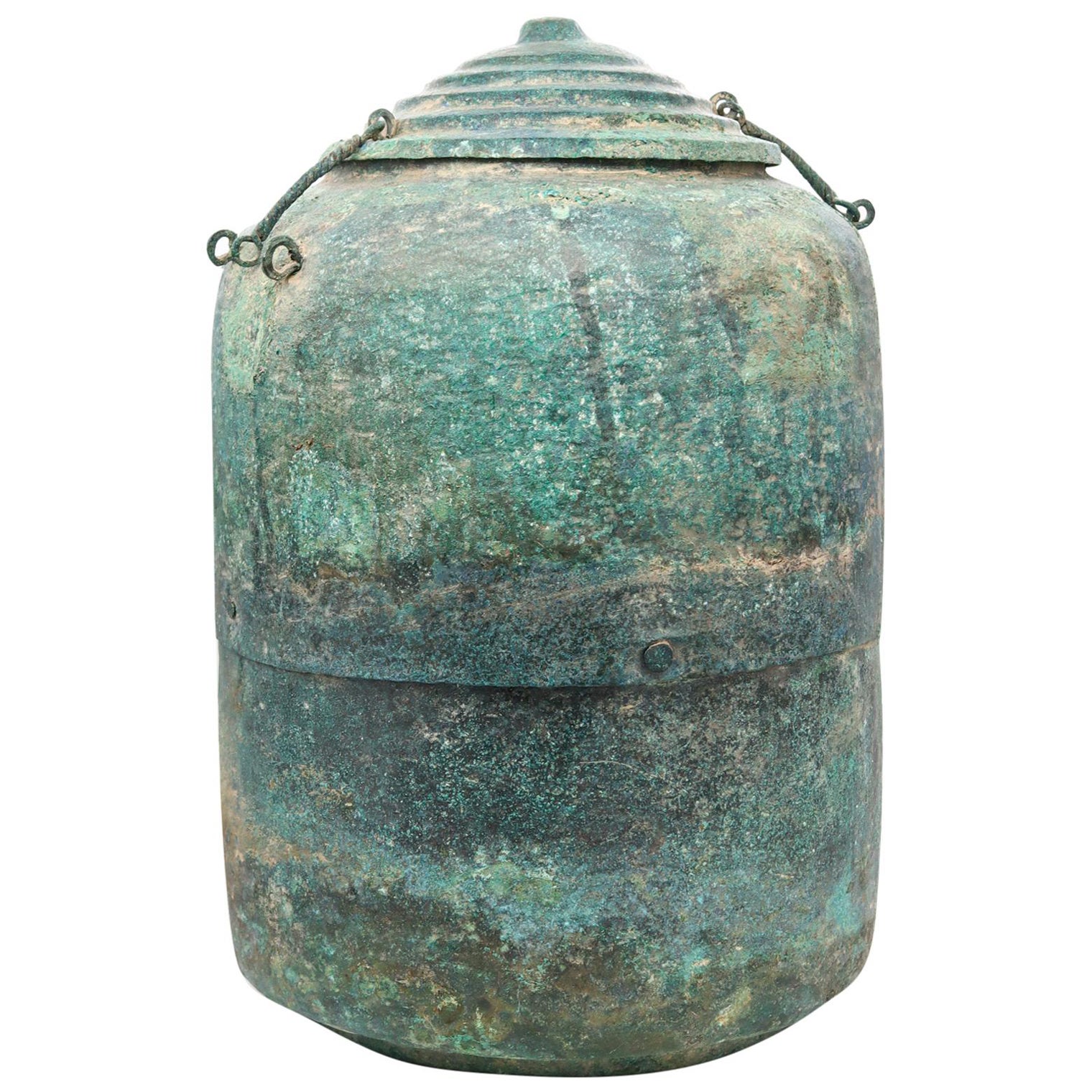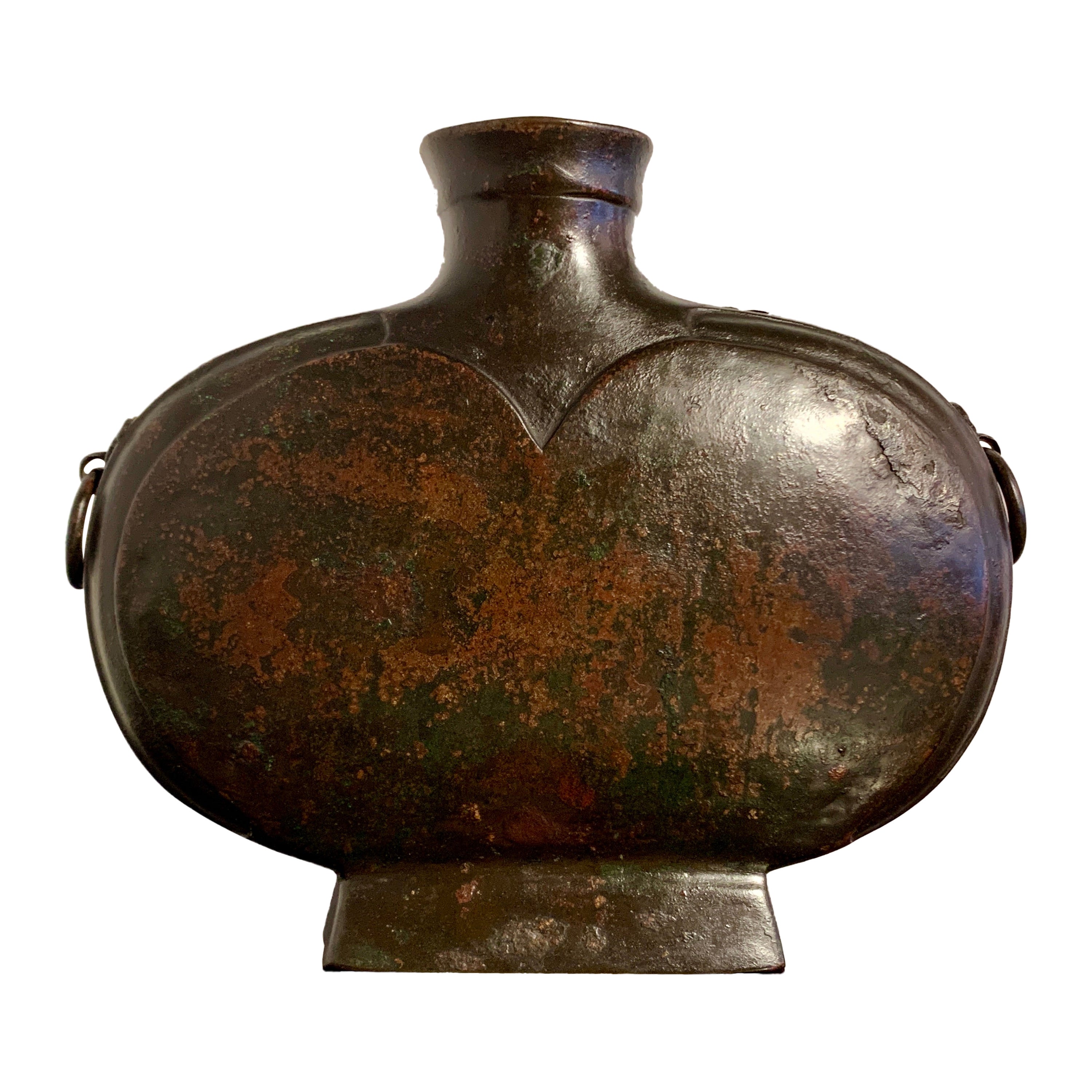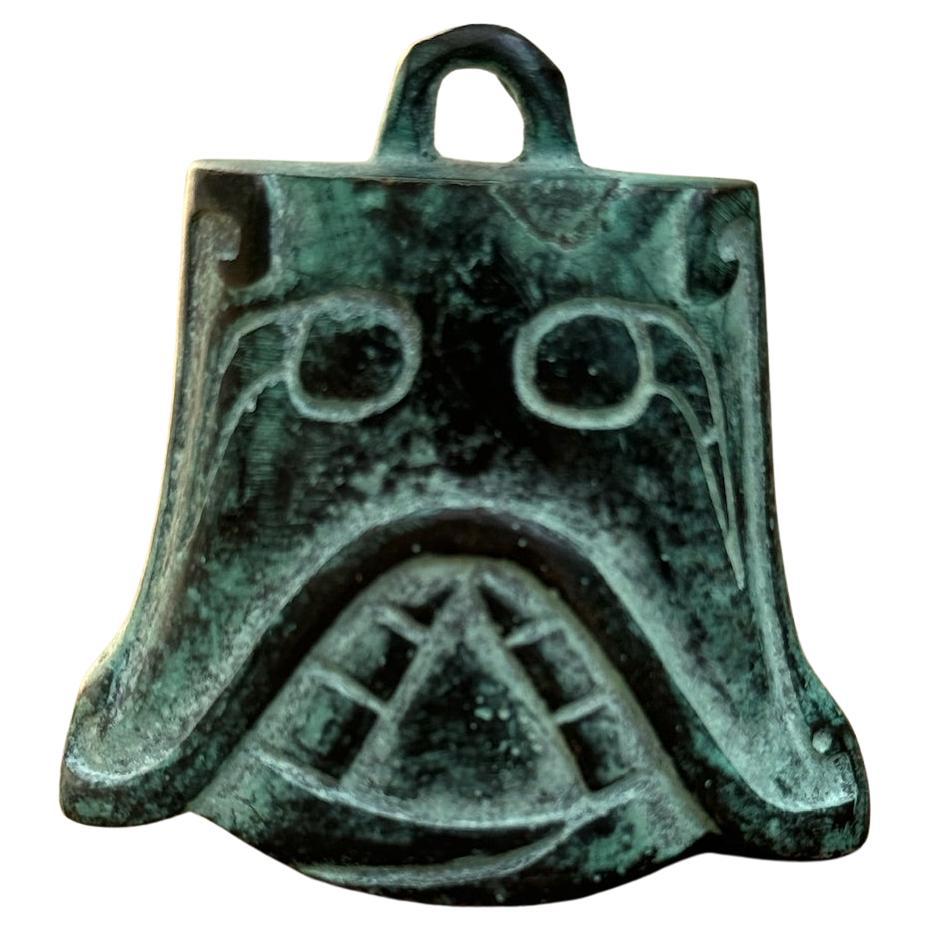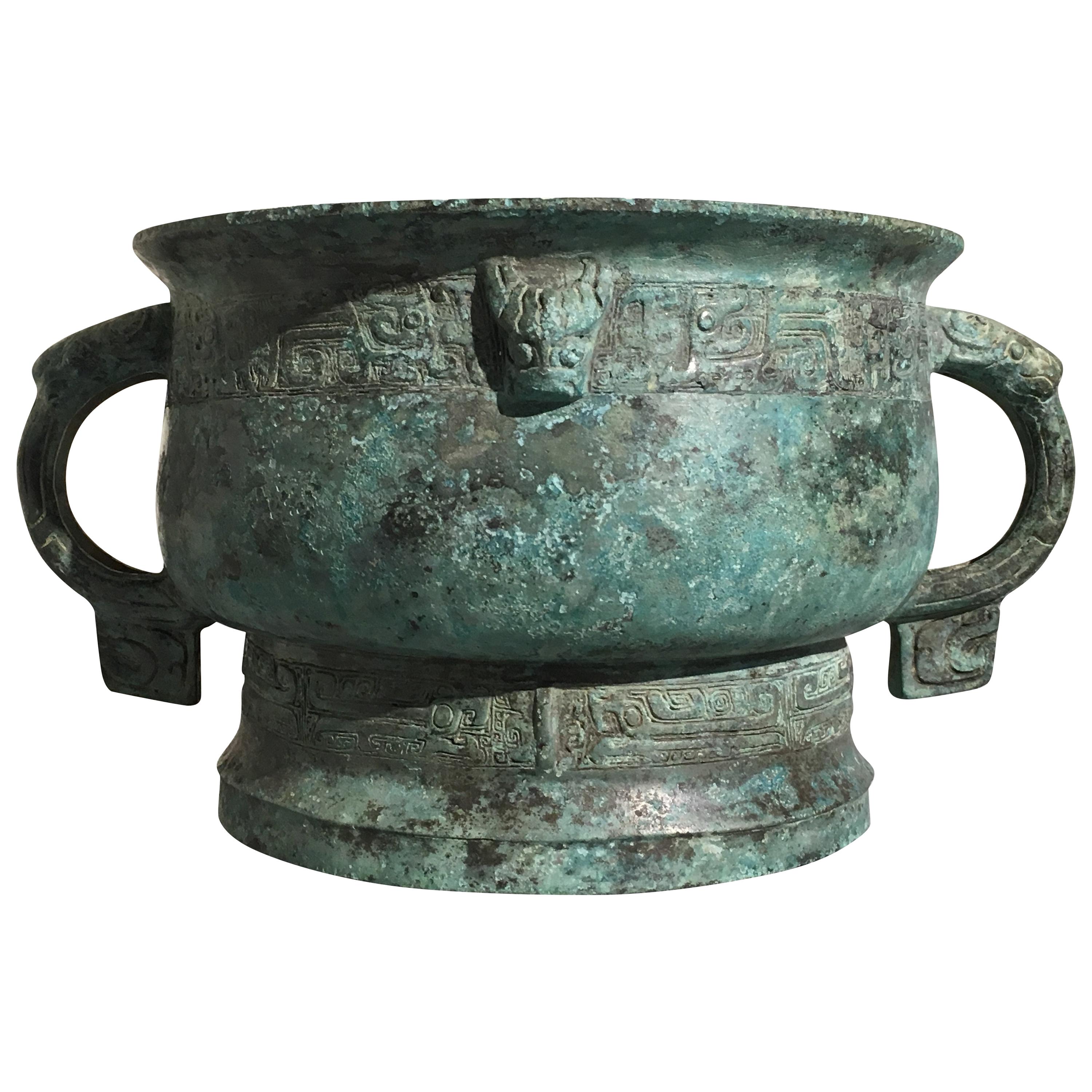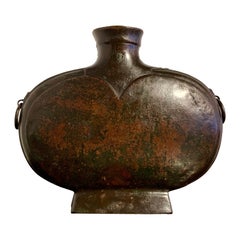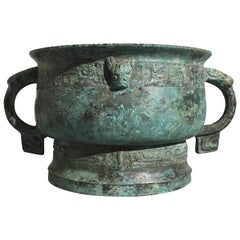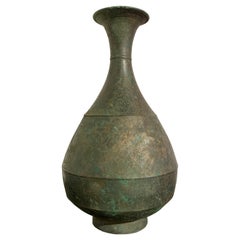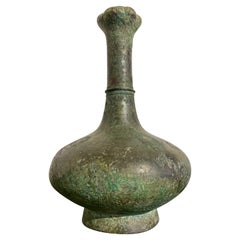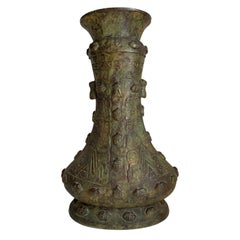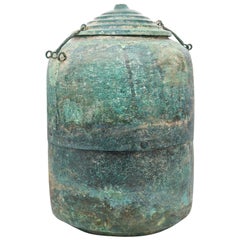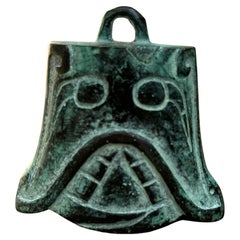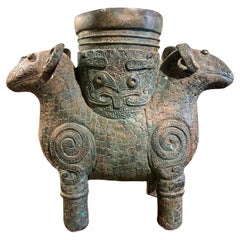Items Similar to Extremely Rare Late Shang Dynasty Inlaid Bronze Gu Vessel
Want more images or videos?
Request additional images or videos from the seller
1 of 11
Extremely Rare Late Shang Dynasty Inlaid Bronze Gu Vessel
About the Item
Of classic trumpet form, with a round, splayed foot, narrow, waisted body and wide, flaring mouth.
Two sets of large, well defined fanged and horned taotie masks cast in high relief over a Leiwen ground serve as the main decorative motif on the foot and body. The neck and mouth decorated with four blades with Leiwen, cast in low relief. Narrow bands of opposing horned dragons have been cast above the taotie on the foot, and below the blades. Four protruding, notched flanges run the entire height of the beaker, separating and bisecting each taotie mask, and bisecting each blade.
Inlays of turquoise, malachite and jade have been applied to fill the entire of the Leiwen ground, and is visible under magnification. Remnants of gilding are also visible under magnification.
The mate to this piece was sold at Bonhams, London in May, 2011, with a Warren King provenance, 1969.
- Dimensions:Height: 12 in (30.48 cm)Diameter: 7 in (17.78 cm)
- Style:Archaistic (Of the Period)
- Materials and Techniques:
- Place of Origin:
- Period:
- Date of Manufacture:12th-11th Century BCE
- Condition:Repaired: Repairs and restorations as expected. Wear consistent with age and use. Minor losses. Minor structural damages. The mouth with some denting, repairs, and punctures, with one loose circular section, approximately 1in. in diameter. The body and base intact, with some loss to the design from oxidation.
- Seller Location:Austin, TX
- Reference Number:1stDibs: LU89475143213
About the Seller
5.0
Gold Seller
Premium sellers maintaining a 4.3+ rating and 24-hour response times
Established in 2001
1stDibs seller since 2010
340 sales on 1stDibs
Typical response time: 1 hour
- ShippingRetrieving quote...Shipping from: Austin, TX
- Return Policy
Authenticity Guarantee
In the unlikely event there’s an issue with an item’s authenticity, contact us within 1 year for a full refund. DetailsMoney-Back Guarantee
If your item is not as described, is damaged in transit, or does not arrive, contact us within 7 days for a full refund. Details24-Hour Cancellation
You have a 24-hour grace period in which to reconsider your purchase, with no questions asked.Vetted Professional Sellers
Our world-class sellers must adhere to strict standards for service and quality, maintaining the integrity of our listings.Price-Match Guarantee
If you find that a seller listed the same item for a lower price elsewhere, we’ll match it.Trusted Global Delivery
Our best-in-class carrier network provides specialized shipping options worldwide, including custom delivery.More From This Seller
View AllChinese Archaic Bronze Wine Vessel, Bianhu, Han Dynasty, China
Located in Austin, TX
A sublime Chinese archaic bronze wine vessel, called a bianhu, Han Dynasty (206 BC - 220 AD), China.
The bianhu with a flattened oblong body,...
Category
Antique 15th Century and Earlier Chinese Han Antiquities
Materials
Bronze
Archaic Chinese Bronze Ritual Vessel, Gui, Early Western Zhou, 11th century BCE
Located in Austin, TX
A stunning and rare Chinese archaic bronze gui, a type of ritual bronze vessel used to hold grain, either for feasting, or for making offerings ...
Category
Antique 15th Century and Earlier Chinese Archaistic Antiquities
Materials
Bronze
Korean Bronze Bottle Vase, Goryeo Dynasty, 11th/12th Century, Korea
Located in Austin, TX
An attractive Korean Goryeo Dynasty bronze bottle vase with traces of gilding, 11th - 12th century, Korea.
The vase of typical form, with a short recessed foot supporting a pear s...
Category
Antique 15th Century and Earlier Korean Metalwork
Materials
Bronze
Chinese Western Han Dynasty Bronze Garlic Head Vase, 206 BC - 25 AD
Located in Austin, TX
A rare and attractive Chinese bronze "garlic head" vase with an encrusted patina, Western Han Dynasty, 206 BC - 25 AD, China.
Of classic form, the bronze vase is set on a short, s...
Category
Antique 15th Century and Earlier Chinese Han Antiquities
Materials
Bronze
Central Javanese Bronze Footed Offering Vessel, 8th-10th Century
Located in Austin, TX
A gorgeously patinated bronze pedestal offering tray, talam, Central Javanese Period, Java, 8th-10th century.
The offering tray of beautiful form and proportions, with a splayed a...
Category
Antique 15th Century and Earlier Javanese Metalwork
Materials
Bronze
Central Javanese Bronze Footed and Lidded Offering Vessel, 8th-10th Century
Located in Austin, TX
A stunning and rare Javanese bronze footed offering vessel and cover, Central Javanese Period, 8th-10th century.
The ritual offering vessel of elega...
Category
Antique 15th Century and Earlier Javanese Metalwork
Materials
Bronze
You May Also Like
Chinese Archaistic Bronze Vase, Circa 1900 Shang Dynasty Style Gu Vessel
Located in Miami, FL
Of Classic vessel form, with an oval, splayed foot, narrow, waisted body and wide, flaring mouth.
Very heavy and archaist vessel with lucky beetles around the sides.
Category
Antique 1890s Asian Archaistic Antiquities
Materials
Bronze
$31,120 Sale Price
20% Off
Free Shipping
China 960 Ad Song Dynasty Very Rare Imperial Period Offering Vessel in Bronze
Located in Miami, FL
Offering vessel from the Chinese Song Dynasty (960/1279 AD ).
A beautiful "offering spiritual vessel" from the Yunnan province region in the ancient China. This rare vessel was created in red bronze during the Song Dynasty period. between 960/1279 AD.
This is one of the most unusual forms of red bronze jar. A large vessel, the sides are virtually perpendicular to the base. The stepped lid design is also among the more rare types. The predominant lid design among the Yunnan offering bronzes is the "wheel" pattern, with a few lids having the lotus design. This is also one of the few bronzes displaying clear riveting of a two-part vessel body, with the original twisted elements
Has a combined measures including the lid of 12.5 by 8.75 inches (31.75 x 22,23 Cm).
The Song Dynasty, was an imperial dynasty of China that began in 960 and lasted until 1279. The dynasty was founded by Emperor Tizu of Song following his usurpation of the throne of the later Zhou, ending the Five-Dynasties and Ten Kingdoms period. The Song often came into conflict with the contemporaneous Liao, Western Xia and Jin dynasties in northern China. After decades of armed resistance defending southern China, it was eventually conquered by the Mongol-led Yuan dynasty.
The dynasty is divided into two periods: Northern Song and Southern Song...
Category
Antique 15th Century and Earlier Chinese Medieval Antiquities
Materials
Bronze
$3,712 Sale Price
25% Off
Shang Dynasty Bronze Bell
Located in West Hollywood, CA
The Shang Dynasty Bronze Bell is an ancient artifact, intricately engraved with mask designs that reflect the artistry and cultural significance o...
Category
Antique 15th Century and Earlier Chinese Antiquities
Materials
Bronze
Archaistic Shang Style Verdigris Bronze 'Double-Ram' Vessel, Zun Circa 1900
Located in Stamford, CT
Archaistic Shang dynasty (1600-1046 BC) style bronze 'double ram' vessel, Zun type.
Of unusual form with a lovely verdigris patina. This wonderful bronze can be a unique vase or centerpiece, or singular decorative sculpture. Circa 1900
The vessel is heavily cast in the shape of two addorsed rams sharing the same hollow body that is raised on four legs and from which rises an oblong neck decorated on each side with a taotie mask below a band of diagonal scrolls. The body is etched with scales and the legs with archaistic spiral motifs.
14 inches high 16 wide 6 deep
The shape and decoration of this unusual vessel are based on late Shang dynasty bronze...
Category
Early 20th Century Chinese Archaistic Metalwork
Materials
Bronze
Japanese Bronze Vessel with Dragon Handles and Falcon Lid
Located in Greenwich, CT
Japanese bronze vessel with pair of dragon handles, falcon lid, birds in landscape and elephant heads base.
Category
Antique 1890s Japanese Meiji Metalwork
Materials
Bronze
Tripod in the shape of a bronze vessel li, Zhou or Shang dynasty
Located in seoul, KR
The tri-lobed shape and combed ridges of this cooking pot increased heating efficiency by maximizing the vessel’s surface area. The shape of a bronze vessel li, with the body rising out of three hollow pointed legs to a wide moiuth with splayed-out rim. The exterior is covered with cord impressed pattern. The surface shows signs of oxidation from being buried in the soil for a long time.
Period: Zhou or Shang dynasty circa 1000 B.C.E.
Medium : Grey earthenware with impressed decoration
Type : Tripod vessel
Size : 29cm (Height) x 35cm(Diameter)
Condition : Good
Provenance : Acquired in late 1990s from Hongkong
Reference :
1) V&A Museum - ACCESSION NUMBER C.87-1954
2) Smithsonian National Museum of Asian Art - ACCESSION NUMBER F1984.13
3) The University of Chicago - OBJECT NUMBER 1989.1
4) The MET - Accession Number: 1972.275.5
5) Kyoto National Museum - Three-footed Earthenware Vessel
* Shang Dynasty Pottery (1600-1046 BCE)
The Shang dynasty, known for its significant advancements in bronze casting, also produced notable pottery. Shang pottery is characterized by its practical use and simple designs, reflecting the utilitarian needs of the society. The pottery from this period includes both coarse wares used for everyday purposes and fine, high-quality ceramics used in ritualistic contexts. Common forms include jars, bowls, and cups, often with a dark, burnished surface. One distinctive feature of Shang pottery is the use of gray clay, and many pieces display clear signs of oxidation, giving them a unique, mottled appearance. The decorations were typically incised or stamped, featuring geometric patterns, zoomorphic designs, and motifs that are also seen in Shang bronze...
Category
Antique 15th Century and Earlier Hong Kong Antiquities
Materials
Pottery
$3,495 Sale Price
50% Off
Recently Viewed
View AllMore Ways To Browse
Antique Brass Jardiniere For Plants Or Flowers
Navy Blue Sideboard Or Buffet
French Or Italian Decorative Glass Soap Dish
Fabulous Square Woven Leather Bench Or Ottoman
Bulova Antique Watches Laies Or Girls 1920s
I Magnim Or Joseph Magnim Suede Orange Coats
Silver Water Pitchers Or Jugs
Blahnik Leopard D Or Say Shoes
Repousse Silver Basket Or Bowl
Baby Silver Or Pewter Gifts
Lucite Or Crystal Centerpiece For Table
Leather Box Or Trunk
All Hand Carved Alabaster Ceramic Or Stone Eggs
Mushroom Stools Stone Or Cement
Old Boat Helm Or Ship Wheel
Antique Bronze Or Brass Side Table
Dark Cherry Or Mahogany Mirrors For Dressers
Conch Pearls Or Pink Pearls

